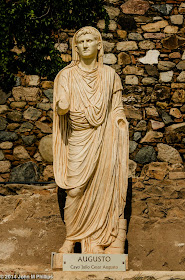Merida was founded in 25 B.C.E by Augustus and is the site of the largest collection of Roman ruins in Spain. We spent the first few hours of our visit clambering around the ruins, which consist primarily of an amphitheater that held some 15,000 spectators and a Vitruvian theater, which held about 6,000. Both were built right around the time of Christ. Interestingly, the two venues are next to one another, as if they were both part of a large entertainment complex. Perhaps one could choose between the amphitheater for blood sport and the theater for more intellectual fare.
I found both venues challenging to photograph in the bright, flat late morning light, which is to say that I am looking for excuses for my results.
First, the amphitheater. Its interior was accessible through any of a series of tunnels leading from the perimeter through and under the oval seating areas. Photographing the tunnels seemed a good idea except their stone surfaces were extremely dark relative to the light on the other end, making for very challenging lighting conditions. This was about the best that I could do. Not exactly a winner.
I did get a few broader shots in an attempt to convey an idea of the larger venue, including a more abstract image that I converted to a black & white.
Exploration of the amphitheater was self-guided and included a number of informative signs that explained--and illustrated--some 15 different gladiator styles that competed in the amphitheater. Apparently, some gladiators favored protective gear, such as armor and shields, over mobility. Oh, and apparently the ladies were voting to "off" the loser.
Then it was on to the Vitruvian theater, where there was a bit more in the way of photo opportunities.
I wasn't able (or simply failed) to get a shot of the theater's overall stage area. Instead, I contented myself with pieces, as in the following.
I thought the best features were the handsome, if incomplete, statuary situated among the supporting pillars.
I could have zoomed in on these pieces, but I thought the adjoining pillars added context to the shots. I did zoom in for the sculpture below of Augustus, but there were no nearby pillars, and I felt the stone wall behind the statue help to create interest. (Too bad about his hands.) Frankly, I didn't feel he came across in this sculpture as charismatic as I would have imagined of someone named Augustus.
Finally, I thought I would throw in a couple of flora shots--of a sycamore, common in the area, that I like for its variegated bark, and a lily that was being photo-bombed by a visiting bee.
John












No comments:
Post a Comment
Note: Only a member of this blog may post a comment.